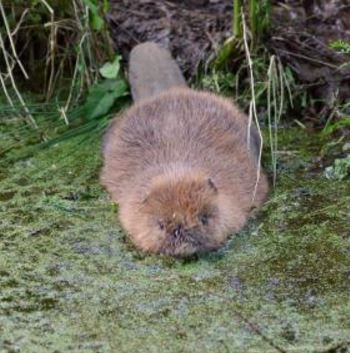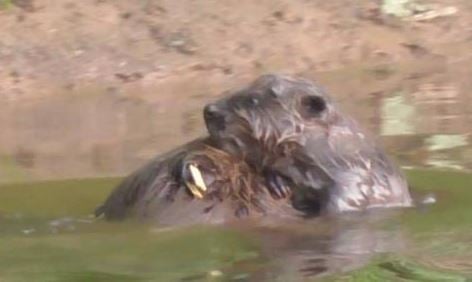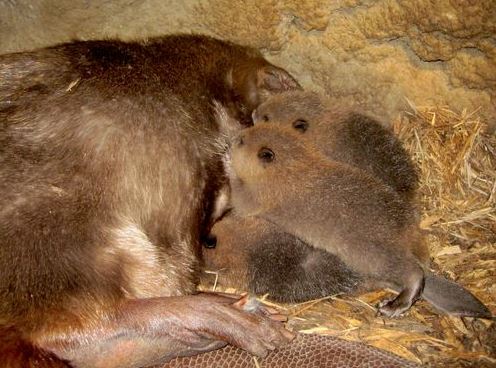An adult female and adult male beaver have been released at a secret location in East Devon near the River Otter on private land. The aim is for them to breed and add genetic diversity to the already breeding population of wild beavers.
In the UK, breeding wild beavers only exist in East Devon, and thanks to the release of these two adults, which was sanctioned by Natural England, the numbers have just increased.
When wild beavers were first spotted in Devon, the UK Government wanted them removed. However, the authorities changed their minds after the Devon Wildlife Trust put forward a proposal.
 Derek Thomas, former Chairman of Wildlife Trusts Wales, and many other nature lovers across the UK, have expressed their joy at the growing beaver population in Devon. (Image: twitter.com/Coffeewarblers)
Derek Thomas, former Chairman of Wildlife Trusts Wales, and many other nature lovers across the UK, have expressed their joy at the growing beaver population in Devon. (Image: twitter.com/Coffeewarblers)
The five-year project, to have a healthy population of wild beavers, is being led by the Devon Wildlife Trust. The charity is studying what the impact of having wild beavers is on the landscape, wildlife, water levels, water quality, local communities and infrastructure, and local farm businesses.
Need to increase beaver genetic diversity
Natural England sanctioned the release of the beavers last yer as part of the River Otter Beaver Trial.
Peter Burgess, Director of Development, Policy and Research, Devon Wildlife Trust, said:
“The genetic diversity of the beavers needed to be increased to ensure that we have a healthy population.”
“So tonight’s release was a crucial and exciting next step in the story of reintroducing this keystone species back to the wild, restoring our river catchments.”
 After being released yesterday, this female beaver took to the water. (Image: devonwildlifetrust.org. Credit: Nick Upton/naturepl.com)
After being released yesterday, this female beaver took to the water. (Image: devonwildlifetrust.org. Credit: Nick Upton/naturepl.com)
Over the coming weeks, the Trust says it plans to monitor the progress of the animals. They have strategically placed cameras in and around their new home so that they can gain valuable insights into beaver behaviour.
Regarding where the two adult beavers were released, Mr. Burgess:
“This release site is the best we looked at. It’s quiet and undisturbed. The ponds are perfect, while they are just a stone’s throw from the river. I want to thank the landowner, a local family who have allowed us to use their land. Without their help this couldn’t have happened. We’ve deliberately not revealed the exact location of the site because we want the beavers to be left undisturbed while they get used to their new surroundings.”
“We will have very privileged access to the secret world of beavers. These are animals that are active only in the evenings, at night and in the early mornings. They are also naturally shy and often difficult to see. The cameras will give us the chance to learn so much about how beavers behave and their impact on the local landscape – this is one of the main objectives of the River Otter Beaver Trial. It will be fascinating to see how this story develops.”
 One of the two beavers released yesterday, coming out of its new house and checking the water. (Image: YouTube)
One of the two beavers released yesterday, coming out of its new house and checking the water. (Image: YouTube)
The first in hundreds of years
Jaz Atkinson, of the Devon Wildlife Trust, says that we now have the first breeding beavers in the English landscape for hundreds of years, “something we’re very proud of.” She adds that this ‘prize’ would not have been possible without the help of local people.
The wild beavers were first spotted in 2010 by Tom Buckley, a former ecologist, who had been walking along the river when he saw some trees that had been gnawed near the bottom. He then placed some cameras down and waited. In the first night “there it was,” said Buckley “It was a beaver.”
Natural England approved the Charity’s proposal in January last year, on condition that the beavers were tested for non-native species. They also had to check the beavers’ DNA to confirm that they were the once-native Eurasian beaver.
Following the test results, the beavers were re-released on the river Otter in March 2015. Within three months, video evidence showed that three kits had been born.
 A kit beaver holding on to its mother on the River Otter in Devon last year. (Image: Devon Wildlife Trust. Credit: Tom Buckley)
A kit beaver holding on to its mother on the River Otter in Devon last year. (Image: Devon Wildlife Trust. Credit: Tom Buckley)
What has the beaver done for us?
The Eurasian beaver (castor fiber) is a large herbivore that was once native to British shores and played a major part in our landscape from prehistoric times. By the 16th century it had been hunted into extinction in Britain, mainly because people sought its meat, fur and scent glands.
When the beaver was gone, we lost our mosaic of lakes, mire, tarns, meres, and boggy places that the animal so skillfully built.
Devon Wildlife trust describes the beaver as a ‘keystone’ species, whose absence has had a profound impact on the ecology of British rivers.
 Beavers have one litter per year, their babies are called kits. They have an average of three kits per litter – ranging from two to six. (Image: zooborns.com)
Beavers have one litter per year, their babies are called kits. They have an average of three kits per litter – ranging from two to six. (Image: zooborns.com)
Experts say their reintroduction could help with the alleviation of downstream flooding, increased water retention, water purification, reduced siltation, and ecotourism.
In mainland Europe where beavers have been reintroduced, a significant increase in revenue and employment from ecotourism followed.
According to the Devon Wildlife Trust:
“The most appropriate sites for initial reintroduction can often be in more remote areas where alternative forms of livelihood from traditional land uses are in decline.”
Video – Male and female beavers released in East Devon
The two beavers, which conservationists hope will breed and add to the local beaver gene pool, were released at a secret location in East Devon near the River Otter.
